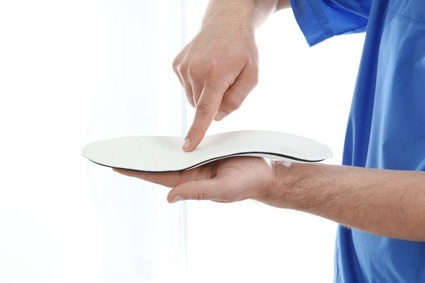 WHAT ARE ORTHOTICS AND WHO NEEDS THEM?
WHAT ARE ORTHOTICS AND WHO NEEDS THEM?
Custom Molded Orthotics (CMOs) are insoles that are placed into shoes to achieve a certain goal. Both children and adults may benefit from them, but not everyone needs them. Each patient must be examined as an individual as no two people have the same feet. The need for CMOs is based on physical examination of the entire lower extremity, biomechanical examination and gait analysis, specific patient complaints, activity levels, and shoe styles worn.
ARE THERE DIFFERENT TYPES?
Accommodative
This type of CMO is used to hug and cushion the foot where there may be a bony prominence, or an area that needs to off loaded. This type will not control or correct the foot. It is merely designed to reduce pressure off certain areas. An example would be a diabetic insert.
Functional
This CMO is used to control several aspects of the foot’s function and biomechanics during gait. There will be individualized aspects built into the CMOs to alter or change the way the foot and ankle move and the way the joints act upon one another while walking or doing physical activity. An example would be an insert that helps correct flat foot.
Corrective
This CMO type is used to attempt correction of a certain deformity. This is most often usually accomplished in children but can be for adults as well. An example would be an insert designed to lift the heel up 1cm due to a limb length discrepancy that arose secondary to an injury.
HOW ARE CUSTOM ORTHOTICS DIFFERENT THAN OFF-THE-SHELF INSERTS?
Custom orthotics are inherently better than store bought inserts in that they are molded specifically to the patient’s feet. CMOs are is made with specific materials and are handmade following a specific individualized prescription by Dr. Legel. An over the counter inert will not have the specific accommodations and tweaks that can control the specific needs of the patient. CMOs are never meant to be “one size fits all.” Also, CMOs can be made specific for special shoes, like high heels or soccer cleats.
HOW ARE CUSTOM ORTHOTICS MADE?
This is a hot topic and an area where lots of debate currently exists. There are 3 main ways to make CMOS: plaster, foam impressions, and computer scanning. When I first started practicing, I only used plaster molds because that’s what I learned in school. That was the gold standard. After being in practice a few years and dealing with dirty plaster stains and crushed molds, I switched to foam boxes. This worked well for a while until one box got lost in shipping. I was informed of this until six months later when the patient called and inquired about his CMOs. It was during that discovery process that I was informed how they make CMOs now. The lab takes a computer scan of my foam box and plaster mold! Well, gosh darn it! Why don’t I eliminate the middleman and just scan them myself? That started my current method of utilizing an iPad with a scanner. Genius invention. Fast, no mess, instant electronic scan sent and stored for perpetuity, and quicker turnaround times for the lab. I can make all the adjustments and accommodations I need on the electronic prescription. I can even order repeat pairs later just pulling up the previous prescription.



